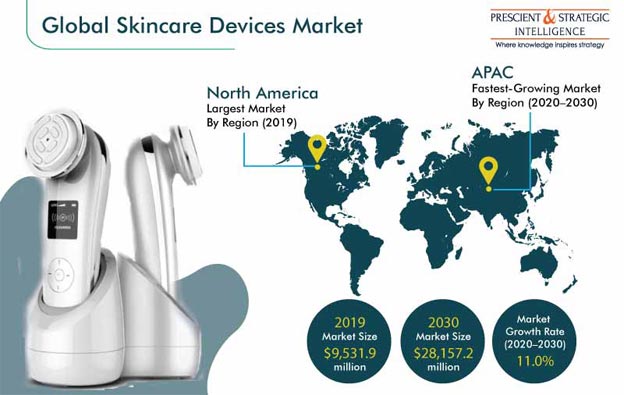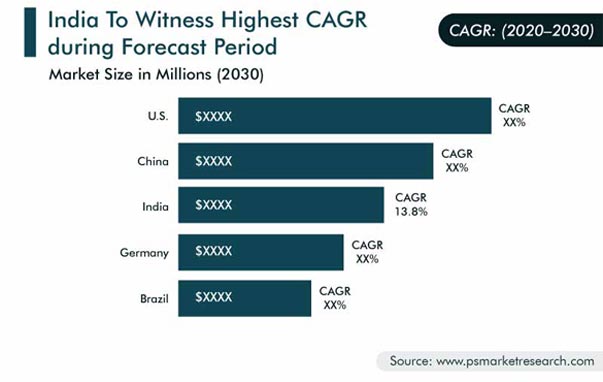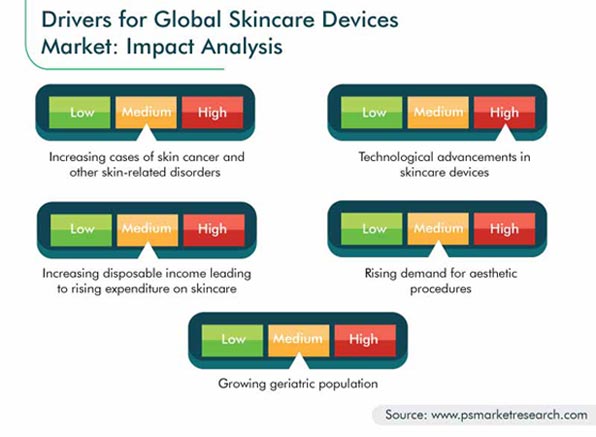Report Code: 10176 | Available Format: PDF | Pages: 261
Skincare Devices Market Research Report: By Product (Treatment Devices, Diagnostic Devices), Distribution Channel (Direct, Indirect), Application (Cellulite Reduction, Disease Diagnosis & Treatment, Hair Removal, Skin Tightening & Body Contouring, Skin Rejuvenation), End User (Dermatology Clinics, Hospitals, Spas & Salons) - Global Industry Analysis and Growth Forecast to 2030
- Report Code: 10176
- Available Format: PDF
- Pages: 261
- Report Description
- Table of Contents
- Market Segmentation
- Request Free Sample
Skincare Devices Market Overview
The global skincare devices market size was $9,531.9 million in 2019, and it is expected to reach $28,157.2 million in 2030, witnessing a CAGR of 11.0% during the forecast period (2020–2030). The major factors behind the growth of the market are the increasing appearance consciousness, surging awareness about beauty devices, rising prevalence of skin diseases, growing geriatric population, rising disposable income, and growing incidence of hormonal disorders.
COVID-19’s rapid spread has had a significant impact on the global healthcare industry. Due to COVID-19, the skincare devices market witnessed a negative impact across the globe, mainly in the first two quarters of 2020. The impact of the global economic conditions and market sentiment directly affects the business of key players. Thus, the recession witnessed by them was primarily due to the lockdown and non-operational dermatology clinics, spas, and salons in several countries. This led to the reduced number of procedures and demand for skincare devices, as a consequence of the widespread financial distress, which has discouraged people from spending on non-essential items.

Treatment Devices Category Accounted for Larger Share in 2019
The treatment devices category held the larger share in the skincare devices market. Many skincare treatment devices, such as liposuction devices and cryotherapy devices, come at quite a high cost, and they also have various applications, such as cosmetic care (augmentation of skin and body appearance), which increases their demand in the market.
Indirect Distribution Channel Expected To Be Faster-Growing Category in Industry
Indirect distribution channels are expected to be the faster-growing category in the skincare devices market in the coming years, on the basis of distribution channel. This can be ascribed to the benefits associated with indirect distribution channels such as higher profit margins on account of the rising customer preference for e-commerce.
Dermatology Clinics Category To Dominate Market throughout Forecast Period
On the basis of end user, the dermatology clinics category is expected to hold the majority share throughout the forecast period, due to the high penetration of skincare devices in dermatology clinics, along with the variety of treatments offered at such centers, including for hair removal, skin rejuvenation, and skin tightening.
Skin Tightening & Body Contouring Application To Experience Fastest Growth
Of all the application categories in the skincare devices market, skin tightening & body contouring is expected to register the fastest growth during the forecast period. This can be ascribed to the increasing prevalence of obesity and growing number of people undergoing liposuction, which requires skin tightening. According to a recent report by the International Society of Aesthetic Plastic Surgery (ISAPS), the total number of surgical liposuction procedures performed in 2018 was 1,732,620, as compared to 1,573,680 in 2017 and 1,372,901 in 2014, which is an around 9.2% increase from 2017 and 20.8% increase from 2014.
North America Accounted for Largest Share in Skincare Devices Industry
North America accounted for the majority share in the skincare devices market in 2019, and it is expected to continue to dominate it throughout the forecast period. The growth of the North American market is mainly driven by the high expenditure on healthcare, increasing prevalence of obesity, high per capita income leading to the affordability of skincare devices and treatments, and health coverage for skin cancer through Medicare and Medicaid in the U.S.
The Centers for Disease Control and Prevention (CDC) expects that around 42% of Americans will be obese by 2030. The increase in the number of obese individuals has further led to a rise in the interest in liposuction, as well as skin tightening and contouring devices, which further supports the growth of the skincare devices industry in the region.
Asia-Pacific (APAC) – Fastest-Growing Region in Global Market
Globally, APAC is expected to advance at the highest CAGR during the forecast period in the skincare devices market, owing to its large population, high prevalence of skin diseases and obesity, and rising aging population. According to the United Nations Economic and Social Commission for Asia and the Pacific (UNESCAP), the number of elderly people is expected to double from 535 million in 2015 to around 1.3 billion by 2050.

Home-Use Skincare Devices Are Key Market Trend
Home-use skincare devices are one of the major trends being observed in the skincare devices market. The continuous technical evolution and growing adoption of skincare devices have increased the focus of manufacturers on developing new, less-expensive, and easy-to-use products, which can be easily operated at home without any technical expertise. Moreover, people are becoming more conscious about looking attractive and young. In order to meet the requirements of consumers, electronic skincare devices are being continuously introduced in the market, for higher convenience, automation, and lesser time consumption compared to the manual ones.

Increasing Cases of Skin Cancer and Other Skin-Related Disorders Are Driving Market
According to the World Health Organization (WHO), around 132,000 cases of melanoma and between 2 and 3 million cases of non-melanoma skin cancer occur every year globally. Some of the common reasons for these skin diseases are stress, anxiety, alcohol and tobacco consumption, UV exposure, pollution, and unhygienic environmental conditions. The rise in the rate of diagnosis of skin cancer and other skin-related diseases, with the help of dermatoscopies and biopsies, and their treatment by laser resurfacing devices and light therapy devices is driving the growth of the skincare devices market.
Growing Geriatric Population Is Expected To Boost Market Growth during Forecast Period
The aging population also plays a pivotal role in the growing demand for skincare devices. Old age is associated with the loss of fibrous tissue and reduced vascular and glandular network in the skin layers. This leads to the occurrence of wrinkles, dryness, pigmentary alteration, and skin sagging. To overcome such skin problems in the elderly population, anti-aging devices are used, which give a younger look by revitalizing and tightening the skin. Therefore, the rising aging population across the globe would lead to the increasing adoption of various types of skincare devices, which would further boost the growth of the skincare devices market during the forecast period.
| Report Attribute | Details |
Historical Years |
2014-2019 |
Forecast Years |
2020-2030 |
Base Year (2019) Market Size |
$9,531.9 Million |
Forecast Period CAGR |
11.0% |
Report Coverage |
Market Trends, Revenue Estimation and Forecast, Segmentation Analysis, Regional and Country Breakdown, Competitive Analysis, Market Share Analysis, Companies’ Strategic Developments, Brand Mapping, Company Profiling |
Market Size by Segments |
By Product, By Application, By Distribution Channel, By End User, By Region |
Market Size of Geographies |
U.S., Canada, Germany, U.K., France, Italy, Spain, Japan, China, India, Brazil, Mexico, Saudi Arabia, U.A.E., Iran, South Africa, Israel |
Secondary Sources and References (Partial List) |
Organisation for Economic Co-operation and Development, United Nations Department of Economic and Social Affairs, World Health Organization, International Society of Aesthetic Plastic Surgery, Centers for Disease Control and Prevention |
Explore more about this report - Request free sample
Technological Advancements in Skincare Devices To Support Market Growth
Many advancements have been taking place in the skincare devices market, as technologically advanced devices can more effectively treat fine lines, wrinkles, sun spots, and cellulite, to enhance the skin’s appearance. For instance, in April 2019, Lumenis Ltd. announced the launch of Legend Pro+, a new face & body platform which offers long-term efficacy, immediate results, and minimal pain, with no need for anesthesia. Thus, the increase in the number of technologically advanced devices and treatments is expected to drive the growth of the skincare devices market.
Market Players Launching New Products and Services to Gain Competitive Edge
The global skincare devices industry is fragmented in nature, with the presence of several key players. In recent years, the major players in the market have taken several strategic measures, such as product launches, partnerships, and facility expansions, to gain a competitive edge.
- In January 2020, Lumenis Ltd. launched the LightSheer Quattro system. This system offers laser hair removal treatments for all skin types, along with treatment for pigmented and vascular lesions, with either an 805 nanometer (nm) or 1060 nm wavelength, with no downtime.
- In April 2019, Lumenis Ltd. announced the introduction of Legend Pro+, a face & body platform which offers long-term efficacy, immediate results, less downtime, and minimal pain, with no need for anesthesia. The platform combines four technologies based on radiofrequency (RF) current, in order to offer a complete toolkit for tailor-made sessions.
- In February 2019, Cutera Inc. launched the excel V+ laser platform. It offers more power and treatment speed and optimized delivery systems for treating vascular lesions and pigmentation issues.
Key Players in Skincare Devices Market include:
-
Allergan plc
-
Merz Pharma GmbH & Co. KGaA
-
Candela Corporation
-
Michelson Diagnostics Ltd.
-
Lumenis Ltd.
-
PhotoMedex Inc.
-
Alma Lasers Ltd.
-
Cutera Inc.
-
Hologic Inc.
-
Panasonic Corporation
-
Bausch Health Companies Inc.
-
Beijing Toplaser Technology Company Ltd.
-
Nu Skin Enterprises Inc.
-
TRIA Beauty Inc.
Skincare Devices Market Size Breakdown by Segment
The skincare devices market report offers comprehensive market segmentation analysis along with market estimation for the period 2014–2030.
Based on Product
- Treatment Devices
- Light/LED therapy & photorejuvenation devices
- Liposuction devices
- Electrosurgical devices
- Laser-based devices
- Cryotherapy devices
- Microdermabrasion devices
- Diagnostic Devices
- Dermatoscopes
- Biopsy devices
- Image-guided systems
Based on Distribution Channel
- Direct
- Indirect
Based on Application
- Cellulite Reduction
- Disease Diagnosis & Treatment
- Hair Removal
- Skin Tightening & Body Contouring
- Skin Rejuvenation
Based on End User
- Dermatology Clinics
- Hospitals
- Spas & Salons
Geographical Analysis
- North America
- U.S.
- Canada
- Europe
- Germany
- U.K.
- France
- Italy
- Spain
- Asia-Pacific (APAC)
- China
- Japan
- India
- Australia
- Indonesia
- Latin America (LATAM)
- Brazil
- Mexico
- Middle East and Africa (MEA)
- South Africa
- Israel
- Saudi Arabia
- Iran, U.A.E
The skincare devices market is expected to advance at a CAGR of 11.0% during 2020–2030.
Home-use skincare devices are the major trend in the skincare devices market.
Dermatology clinics require a large number of devices for skin tightening, hair removal, and skin rejuvenation treatments, which is why they will be the largest skincare devices industry end user.
Treatment devices are more-widely used in the skincare devices market.
North America will dominate the skincare devices industry during 2020–2030.
Want a report tailored exactly to your business strategy?
Request CustomizationWant an insight-rich discussion with the report author?
Speak to AnalystOur dedication to providing the most-accurate market information has earned us verification by Dun & Bradstreet (D&B). We strive for quality checking of the highest level to enable data-driven decision making for you
Our insights into the minutest levels of the markets, including the latest trends and competitive landscape, give you all the answers you need to take your business to new heights
With 24/7 research support, we ensure that the wheels of your business never stop turning. Don’t let time stand in your way. Get all your queries answered with a simple phone call or email, as and when required
We take a cautious approach to protecting your personal and confidential information. Trust is the strongest bond that connects us and our clients, and trust we build by complying with all international and domestic data protection and privacy laws